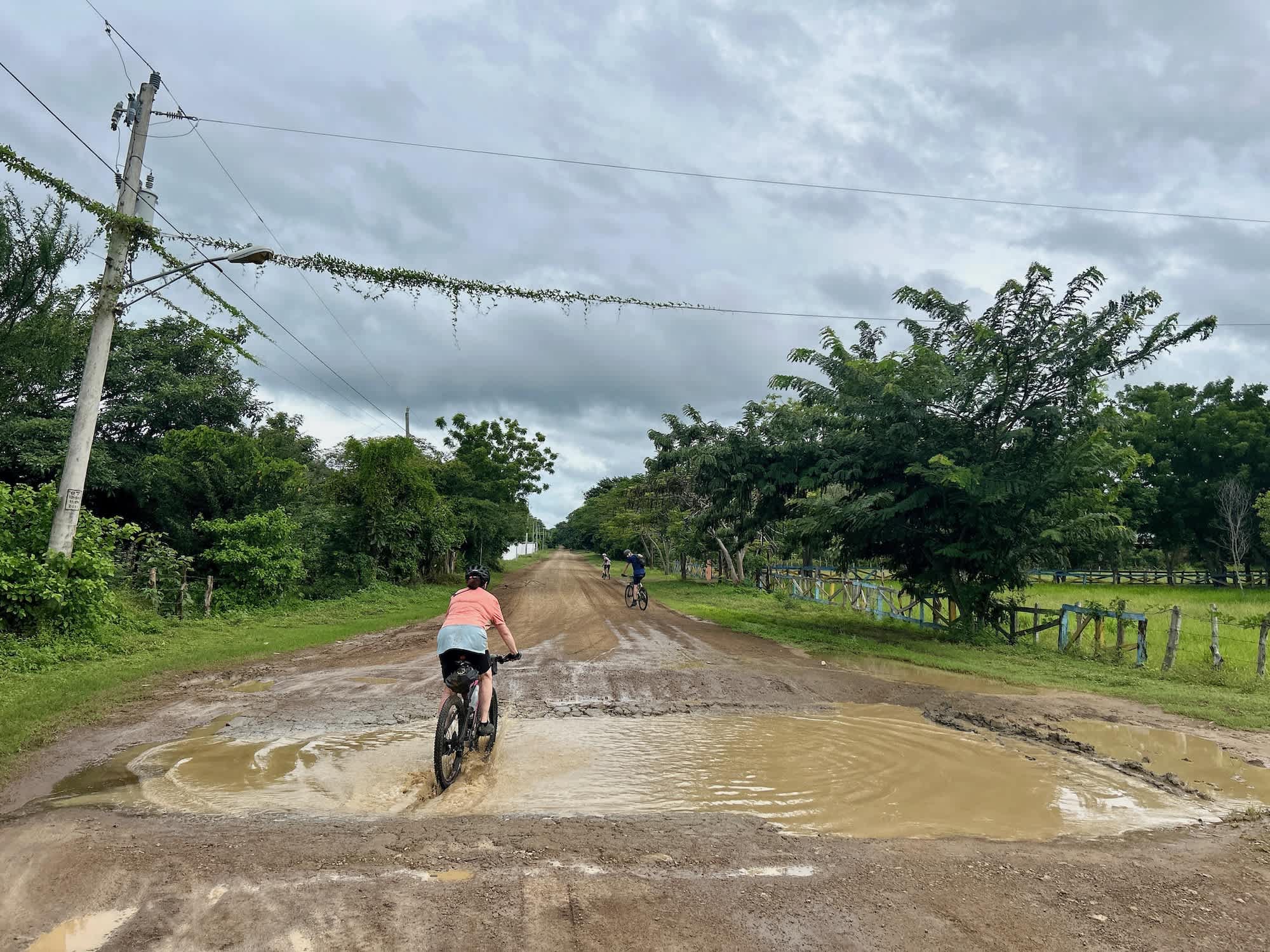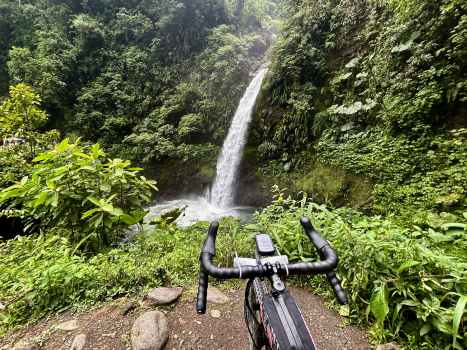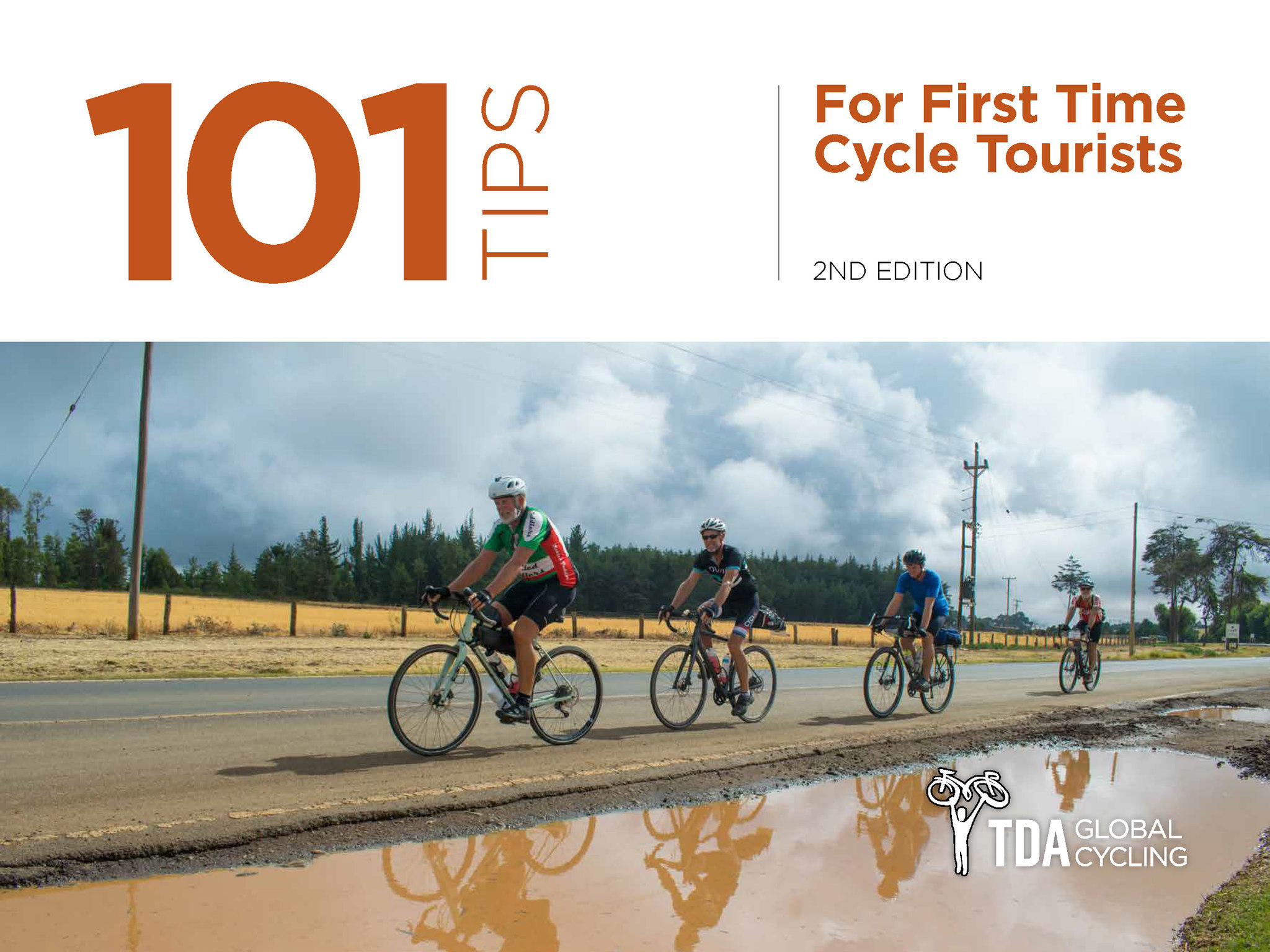Blog
Seven Tips For Cycling On Rough Roads
HOW TO PREPARE: An 8 part series to get you ready for your first TDA tour. Click here to read more.
Becky Timbers is the Content Creator on the 2023 Ruta Maya. In this report, she takes a look at cycling on rough roads.
One of the first challenges the riders of the Ruta Maya tour came face-to-face with were the road conditions. We had a few days of tarmac and smooth pavement after leaving our hotel in San José, Costa Rica, but that tarmac soon turned into long stretches of rough and bumpy gravel roads. In fact, much of the Ruta Maya route was designed to be on dirt. This is a pretty big deviation from most TDA tours, where the cycling is on paved roads (although ‘paved’ can sometimes be a generous term).
As many of our riders soon discovered, biking on loose gravel roads requires a different set of skills than riding on pavement. It can be jarring on the whole body and maintaining traction can be difficult, especially on steep hills, which seem to be quite common in Central America. As a mountain biker and gravel rider, though, this is my terrain! I love the challenge that off-pavement riding presents including picking good lines and using my body weight to maintain traction. If you struggle with bike handling skills on rough and rugged roads, here are my best tips for a more enjoyable – and successful – ride.
#1 Choose the right tires
Tires can make or break your rough road riding experience. Many bicycle tourers opt for narrow, ‘slick’ or ‘semi-slick’ tires that roll fast on pavement, but these aren’t going to do you many favours when it comes to rough roads. If you know your bike tour will at least partially be on rugged dirt roads, you’ll want to bring a more appropriate set of tires – ones that are wider and have larger knobs for grip. For the Ruta Maya tour, we recommended that riders bring two sets of tires: one for on-pavement riding and one for off-pavement riding. For the off-road sections, tires that are between 45-50c (or 1.75 – 2 inches) are a great choice. The wider width gives riders more stability and balance on loose terrain.
Tire tread is another consideration. Tread pattern and stoutness of the tire lugs will determine how much traction and grip you’ll have on loose sections. The burlier the tire tread, the more traction you’ll be able to get. However, it’s a balance. Heavily lugged mountain bike tires aren’t as fast-rolling because of the large tire knobs, so keep that in mind when choosing your off-pavement tires. Three great gravel tires to consider: Pirelli Cinturato Gravel, the Schwalbe G-One Overland and the Teravail Rutland Light & Supple.

Wider tires provide better stability, traction, and comfort on rougher terrain
#2 Lower tire pressure
Lowering your tire pressure is a good way to increase traction and grip, especially on steep, loose climbs. If you find that your back wheel is spinning out or you can’t get traction, try letting a bit of air out of your tires. Lower PSI will also help with comfort on bumpy roads. Don’t go too low, though, or you run the risk of denting a rim or ‘burping’ even more air out of your tire.
#3 Don’t get your weight back!
On downhills
One of the biggest mistakes I see riders make when descending steep grades is to ‘get their weight back’. I’m sure we’ve all been told to do this at some point during our cycling careers, but shifting our weight to the rear makes descending unstable and even dangerous. If your weight is at the back of your bike, you lose a ton of control over steering (which is important…) and you also lose traction on the front tire (which is also important). Instead, when descending keep your weight over your pedals and lower your centre of gravity. An easy way to do this is to drop your weight into your heels while keeping your chin over your stem.
On Uphills
Climbing on loose or rutted roads also presents its own challenges – namely maintaining weight over the front wheel and preventing the rear tire from spinning out. The key here is to stay seated, but shift your body weight to the nose of your saddle. This forward position will keep some weight on the rear tire to prevent it from loosing traction, but it will also shift some weight over the front of your bike so the front wheel stays grounded. A lot of cyclists are used to standing up on steep inclines, but if you’re trying to power up a gravely or rutted road, shifting your weight that far forward will often result in your back tire spinning out because it has no pressure or weight on it.

When climbing loose roads, shift your weight to the nose of your saddle to keep traction on both front and rear wheels
#4 Modulate your braking
Braking may seem like an easy thing to do, and for most cycling, it is. But when you’re riding on poor roads and the descents are not straightforward, braking becomes a bit more complex. The secret to good braking on loose or sandy roads is to modulate your brakes. This means slowly squeezing and releasing your brake levers at consistent intervals instead of continually clutching them like many riders do on pavement descents. By modulating your brakes, you’re doing a few things:
– Preventing your rear wheel from locking up and skidding
– Keeping your arms and hands loose so they can absorb the bumpy terrain (ie not death gripping)
– Allowing both tires to keep rolling smoothly so they can pass over obstacles on the road
If the descent is very steep, you can also practice using more front brake, which is your stronger brake. Many cyclists are scared of their front brake because they’ve had experience with going over the bars. But, if your body position is good (weight is in your heels, center of gravity is over your pedals, and chin is over your stem) and you’re modulating your brakes, the risk of going OTB is little to none.

Squeeze and release your brakes when descending loose sections to avoid skidding
#5 Keep a steady pedalling cadence
Pedalling cadence is something not many riders think about, but it’s a great tip for riding on rough roads. A steady cadence will help smooth out your ride and even help keep traction on steep climbs. Here are two pointers to help achieve a steady cadence:
1. Slow your pedalling and shift accordingly. A steady pedalling rhythm is about one pedal rotation per second.
2. An easier gear isn’t always better.
If you legs are spinning it’ll be harder to maintain traction.
#6 Look ahead & choose your line
You should always be looking ahead when you’re cycling, but this is even more critical when riding rough and rutted roads. You want to make sure you see everything in front of you well in advance so there are no surprises that could cause a crash.
An important part of looking ahead is also choosing your line. We use this a lot in mountain biking when there isn’t a clear path through a section of trail. Typically, the ‘best’ line is the easiest one – there are few obstacles in your way and you don’t need to turn or steer too much. For washed out roads, it’s best to stay high if possible and not get sucked down into the ruts. For loose, gravely roads, look for a line that has been packed down by cars or sometimes the edge of the road is less treacherous.

Sometimes the best line is straight through 🙂
#7 Stay relaxed
Lastly, stay relaxed! I know this is easier said than done, but if you can relax your body on bumpy and choppy terrain, you’ll have a more comfortable and safer rider. Remember to breathe (it’s easy to hold your breath in when tackling a rough section) and don’t rush your ride. Often, slow and steady is the best approach for tough stretches. And if the riding becomes too challenging, walking is a great option.
RELATED
TOUR

Ruta Maya
This incredible cycling adventure will take riders across Central America, from Costa Rica through Nicaragua, Honduras, Guatemala, Belize and on into...
How to Prepare
An 8 part series to get you ready for your first TDA tour. Click here to read more.
 REGISTER NOW
REGISTER NOW




5 Comments for "Seven Tips For Cycling On Rough Roads"
Thanks. Good, helpful review.
Very helpful for me as a relatively novice rider!
Good read! Confirmed my experience of my first year of serious mountain and gravel biking.
Excellent article and some really good tips for adapting your riding style to help make rough sections more enjoyable. Tire width, tread and pressure are critical elements that people often underestimate in terms of their importance. It takes some trial and error to find what works best for each of us, but I’d highly recommend anyone interested in the relationship between tire width, tire tread, tire sidewalls and tire pressure to check out Jan Heine’s newsletter (it’s free) that he publishes on his company website: ReneHersecycles.com. Jan has done extensive research into how tires perform and he regularly dispels a lot of myths about “skinny” tires being faster. I should add Jan’s a serious randonneur and routinely puts his theories to the test out in real world events. Thanks for writing such a detailed and helpful article Becky.
All good tips. My 80,000km round the world used 700×40’s for all terrain and these tips are excellent, in my experience.